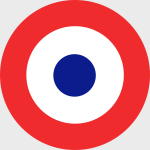Hobby Master HA9802 French Dassault-Breguet Mirage IIICJ Fighter - EC 3/10 Vexin, #10-LB, Djibouti AB, Djibouti, October 1984 (1:72 Scale)
"If one has not given everything, one has given nothing."
- Georges Guynemer
 By the late 1980s, the Mirage 2000 was beginning to age compared with the latest models of U.S. F-16 fighters, so Thomson-CSF began work on a privately funded update of the Mirage 2000C which was to be named the Mirage 2000-5. A two-seat Mirage 2000B prototype was extensively modified as the first Mirage 2000-5 prototype, and it first flew on October 24th, 1990. A Mirage 2000C prototype was also reworked to a similar standard, making its initial flight on April 27th, 1991. The production aircraft entered operational service in 1997. A two-seat version was developed as well, whose rear seat has a HUD but not an associated head-level display and lacks a built-in cannon, although cannon pods can be carried.
By the late 1980s, the Mirage 2000 was beginning to age compared with the latest models of U.S. F-16 fighters, so Thomson-CSF began work on a privately funded update of the Mirage 2000C which was to be named the Mirage 2000-5. A two-seat Mirage 2000B prototype was extensively modified as the first Mirage 2000-5 prototype, and it first flew on October 24th, 1990. A Mirage 2000C prototype was also reworked to a similar standard, making its initial flight on April 27th, 1991. The production aircraft entered operational service in 1997. A two-seat version was developed as well, whose rear seat has a HUD but not an associated head-level display and lacks a built-in cannon, although cannon pods can be carried.
Improvements included the Thales TV/CT CLDP laser designater pod as well as the Thales multimode RDY (Radar Doppler Multitarget), which allows detection of up to 24 targets and the ability to simultaneously track 8 threats while guiding 4 MICA missiles to different targets. Updates to defensive systems included the ICMS 2 countermeasures suite and the Samir DDM missile warning system. ICMS 2 incorporates a receiver and associated signal processing system in the nose for detecting hostile missile command data links, and can be interfaced to a new programmable mission-planning and post-mission analysis ground system. Avionics were also updated, using a new Night vision-compatible glass cockpit layout borrowed from the Rafale, a dual-linked wide-angle Head-up display, and HOTAS controls. The Mirage 2000-5 can also carry the oversized drop tanks developed for the Mirage 2000N, greatly extending its range.
Dassault needed an order from the AdA to help promote foreign sales and, in 1993, the AdA decided to upgrade 37 of their existing Mirage 2000s to the 2000-5 specification as a stopgap before the arrival of the Rafale in AdA service. The upgraded aircraft were redesignated Mirage 2000-5F, and became operational in 2000. They retained the old countermeasures system with the Serval/Sabre/Spirale units and did not receive the ICMS 2 system. The AdA is now considering upgrades for the type, including the MIDS datalink, MICA IR support, and the Thales Topsight helmet-mounted display and sighting system.
Pictured here is a 1:72 scale replica of a French Dassault-Breguet Mirage IIICJ fighter that was attached to EC 3/10 Vexin, #10-LB, then deployed to Djibouti AB, Djibouti, during October 1984.
Pre-order! Ship Date: February 2025.
Dimensions:
Wingspan: 7-3/4-inches
Length: 5-inches
Release Date: ?
Historical Account: "Strange Bedfellows" - Camp Lemonnier is a United States Naval Expeditionary Base, situated next to Djibouti-Ambouli International Airport in Djibouti City, and home to the Combined Joint Task Force - Horn of Africa (CJTF-HOA) of the U.S. Africa Command (USAFRICOM). It is the only permanent U.S. military base in Africa. The camp is operated by U.S. Navy Region Europe, Africa, Southwest Asia; CJTF-HOA is the most notable tenant command located at the facility as of 2008.
Camp Lemonnier was originally established as a garrison for the French Foreign Legion. The base was leased by Djibouti to the United States in 2002, along with the right to use the neighboring airport and port facilities. The base supports Operation Enduring Freedom - Horn of Africa (OEF-HOA) and is the centerpiece of a network of around six U.S. drone and surveillance bases stretching across the continent. The latter air bases are smaller and operate from remote hangars situated within local military bases or civilian airports. Due to its strategic location, Camp Lemonnier also serves as a hub for aerial operations in the Persian Gulf region.
Djibouti is strategically located by the Bab-el-Mandeb Strait, which separates the Gulf of Aden from the Red Sea and controls the approaches to the Suez Canal. As a result, the country hosts many other foreign military bases, including a Chinese naval base, a French airbase, an Italian Support Base and a Japanese base. The United States Pentagon has accused the Chinese of targeting U.S. military aircraft with a high-powered laser near its Chinese military base in Djibouti.
Unlike French troops, who are allowed to enter Djibouti city and interact with the locals, US troops may only leave Camp Lemonnier by special permission, and most of Djibouti City is off limits. However, in 2015, a US military investigation concluded that 19 members of the U.S. National Guard, 775th Engineering Division, had sex with prostitutes at an off-base residence in Djibouti. Sex trafficking in, and around, Djibouti has been a persistent problem.


